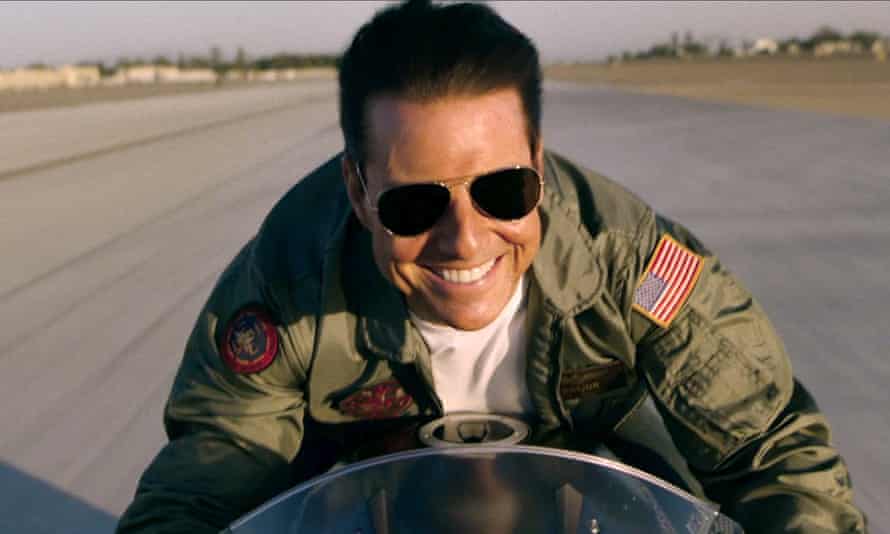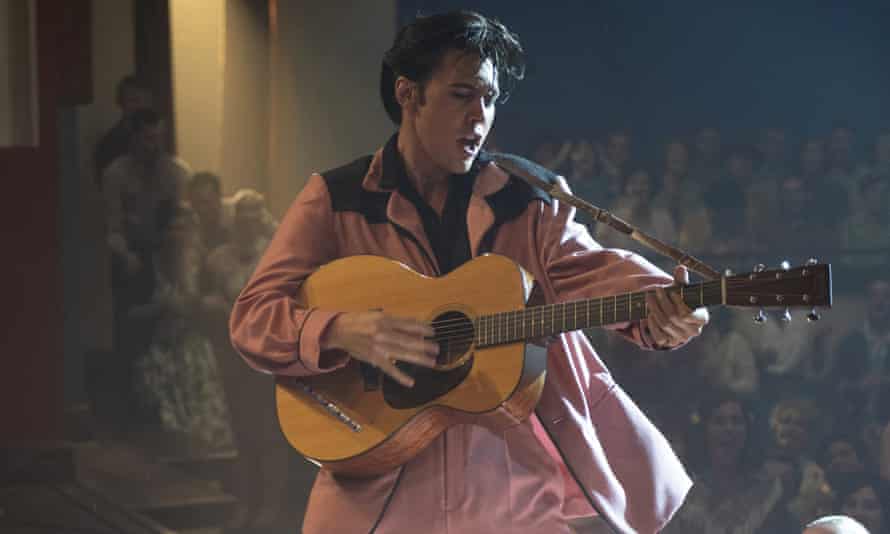The Truman Show is a 1990s Hollywood movie about a man who lives in a bubble, cut off from the world. As played by Jim Carrey, Truman Burbank – surrounded by actors, his every move dogged by cameras – stares at a stage set and believes that it’s real. In the film’s final scene he climbs the stairs, finds a door and prepares to escape his gilded cage.
That keynote image – Truman’s ascent against a painted sky – is now the official poster for the forthcoming Cannes film festival, soon to be plastered on programmes, Blu-Tacked in shop windows and rigged like a godhead across the concrete Palais. And while we should be wary of judging an event by its cover, the choice of image feels apt. The organisers picked it, they say, because it “represents a poetic celebration of the quest for expression and freedom”. Others may read it as a self-owning comment on the festival as a whole.
Sign up to our Inside Saturday newsletter for an exclusive behind-the-scenes look at the making of the magazine’s biggest features, as well as a curated list of our weekly highlights.
That’s the perennial question about Cannes, that millionaire’s playground on the Côte d’Azur. Is it the bubble or the door, the sickness or the cure? A creative response to the woes of the world or a means of laundering its worst excesses? Nobody is certain. The jury’s always out. Cannes thrives on frictions, contradictions; that’s part of its appeal. But pull the elastic too hard and sooner or later it snaps.
This year marks the festival’s 75th edition, a birthday of sorts. It provides the perfect excuse to rewind through the event’s past, celebrating its history as a home for provocation, a seedbed for the Nouvelle Vague, New Hollywood, the buena onda of Latin American cinema. But it’s also a chance to reset the compass, to map out the future. Judged on face value, this year’s lineup is terrific. There are new films from David Cronenberg, Claire Denis, George Miller, Kelly Reichardt; a shrewd balance of arthouse delicacies with tasty cinematic junk food (Top Gun: Maverick; Baz Luhrmann’s Elvis biopic). It’s almost enough to distract from the troubles piling up all around. Industry upheaval. The pandemic. Ukraine.

It is a good year already for the British producer Mike Goodridge, who has two films in the main competition. Triangle of Sadness is the new comedy from Ruben Östlund, who won the 2017 Palme d’Or for his art-world satire The Square. Tchaikovsky’s Wife is a period drama by the dissident Russian director Kirill Serebrennikov. Cannes has banned official Russian delegations this year, but individual artists (most of whom are at odds with the Putin regime anyway) are always welcome. The producer thinks that’s fair enough. Serebrennikov, he explains, has just spent several years under house arrest: “He’s the last person who should be receiving a cultural boycott.”
Goodridge first came to Cannes back in 1991. He has been a journalist, a sales agent and a festival director himself. So he’s come at the event from pretty much every angle and largely made peace with its manifest contradictions. Cannes, he argues, is still the world’s most exciting film festival. Moreover, it may be the last great champion of cinema itself, doggedly wedded to the old theatrical business model and forcing made-for-TV Netflix content to screen in Venice instead. “Cannes is dedicated to protecting the sacred art of cinema,” he says. “And the Cannes Palais, as well as being a place of discovery, is cinema’s ultimate cathedral. It changes your life. It changes the way you see the world.”
Inevitably, there’s a downside, too. “The worst thing about Cannes, I suppose, is the rarefied nature of it. It is elitist. It is snobby. And yes, it is slow to change. The selection process isn’t flawless. There needs to be more fresh blood, just to mix it up. You do get sick of seeing the same old faces in the main competition.”
We’re back to those Cannes frictions again. For every action, a reaction. For every high, a crushing low. I have been coming to the festival for years and still can’t pin it down. It is at once radical and hidebound, serious and silly, horribly hierarchical and airily democratic.

Or to put it another way, Cannes is the Walt Whitman of film festivals. It contains multitudes. It contradicts itself. Outside the Palais, the impenetrable arthouse puzzle is accorded the same red carpet treatment as the A-list Hollywood blockbuster. Inside, the highbrow main competition is offset by a lowbrow film market, selling Asian erotic thrillers with garbled English blurbs (“In a small apartment, she was almost like an old goddess to him”). At night, on the harbour, the oligarch yachts double as film party venues. The revellers raise their champagne flutes en masse to toast the latest social-realist cri de coeur from Bucharest or Timbuktu.
Undeniably, it used to be more riotous, more of an obvious circus. I miss the human traffic that used to surge along the Croisette before the security was tightened. The upstart student film-makers bellowing into loud-hailers; the newspaper vendor shouting “Libération!” on the steps. In recent years, Cannes has become safety-conscious, almost cloistered. But does that make it more of a bubble than before?
The film-maker Mark Cousins vehemently disagrees. “I have no time for this argument,” he says. Firstly, Cousins explains, Cannes’s natural affinity has always been for the innovator, the underdog, the sort of artists who would normally be left outside in the cold. Secondly, crucially, it remains a physical festival, “a moment in the moshpit”, a vital connection with the offline world. “What used to be called life,” he says.
Goodridge compares Cannes to a cathedral. Cousins, for his part, reaches for nautical similes. The festival, he tells me, is like a sea wall against erosion, or a lighthouse in the storm, “battered but sentinel”, directing its beam into the globe’s four corners. That’s a bold claim to make about an event that once staged a stunt involving Jerry Seinfeld in a bee costume on a zip-wire, but he may be right. Because if there is a comedy Cannes and a celebrity Cannes, it follows that there might be a core-principles Cannes, something to cling to when everything else blows away. Also, it’s comforting to think of Cannes as the lighthouse, honest and unyielding. Better that than seeing it as the storm itself.

When people speak of Cannes’s radical heyday, they invariably cite the insurrectionist fireworks of May 1968, when Godard and Truffaut stormed the main hall and brought the event to a juddering halt. But Cannes’s political roots go much deeper than that. This is the 75th festival, although by rights it should be older. It was explicitly conceived as a carnival of resistance, a riposte to the fascist event in Venice, which made Joseph Goebbels its guest of honour and awarded the “Mussolini Cup” to a Leni Riefenstahl picture. The inaugural Cannes festival was due to get under way on 1 September 1939. When Hitler’s tanks rolled into Poland, the festival was cancelled a few hours in.
I sometimes think Cannes’s champions could make more of this genesis. It’s like a superhero origin tale: a call to arms, a rising up. Politics is in Cannes’s DNA. The French writer Agnès Poirier argues that its history is fundamental. “More than any other festival, it has never been afraid to take a stance on the world,” she says.
Cannes was built in a spirit of inclusion, tolerance and empathy with other cultures. That’s why it likes provocative artists who rattle our cages (Hitchcock, Gaspar Noé, Lars von Trier). It’s why it loves dissident artists who shed a light on injustice. Sergei Loznitsa’s film Donbass sounded the alarm of a burgeoning crisis in eastern Ukraine. Andrey Zvyagintsev’s Loveless warned of creeping moral rot among the Moscow middle class. Cannes plays both sides, but it engages with the world. The photocalls and fashion disasters ensure that the festival is noticed. But those stage-managed frivolities sell its produce far and wide.
“Well, it’s interesting that you would say it’s frivolous,” says Poirier. “That’s probably a British perspective. In France, Cannes has never been seen as frivolous. For us it’s very serious. It’s our political class. It’s our university of geopolitics. It’s where we come for knowledge of the parts of the world we’ve never visited.”
For 12 days this month the Cannes faithful will gather outside the Palais. They’ll kick their heels beneath the giant image of Truman Burbank climbing against the painted sky, forever hunting for his exit route. Once through the gates, those guests have free run of the programme; the only limit is time. They may see a masterpiece. They may see a turkey. They may be whisked off to São Paulo, Harare or Muscat. They may witness something that changes the way they see the world. Sure, Cannes is a bubble. But the movies: those are doors.
The 75th Cannes film festival runs from 17 to 28 May.


